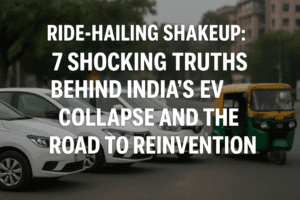Ride-Hailing Shakeup: 7 Shocking Truths Behind India’s EV Collapse and the Road to Reinvention
India’s ride-hailing sector faces upheaval as BluSmart, a leading EV cab service, halts operations amid financial ties to scandal-hit Gensol Engineering, leaving customers and drivers in limbo. Competitors like Rapido and Namma Yatri are disrupting traditional commission models by adopting driver-friendly subscription fees, pressuring giants Uber and Ola to adapt. Regulatory uncertainty looms as GST rules for subscription-based platforms remain unresolved, while Karnataka’s bike taxi ban highlights fragmented policies stifling innovation.
BluSmart’s collapse—rooted in debt defaults and asset seizures—exposes risks in capital-heavy EV ventures, creating opportunities for agile startups like Shoffr. However, the sector’s projected growth to $4 billion by 2032 hinges on resolving legal ambiguities, fostering fair driver earnings, and rebuilding trust in sustainable mobility. As players navigate turbulence, the shift toward equitable pricing and regulatory clarity will determine whether India’s ride-hailing evolution prioritizes resilience over reckless expansion.

Ride-Hailing Shakeup: 7 Shocking Truths Behind India’s EV Collapse and the Road to Reinvention
The sudden halt of BluSmart’s electric vehicle (EV) fleet operations has sent shockwaves through India’s $1-billion ride-hailing sector, exposing vulnerabilities in business models, regulatory gray areas, and the high stakes of sustainable mobility ambitions. As the dust settles, the industry faces a pivotal moment of reinvention—one that could redefine how millions commute.
BluSmart’s Collapse: A Cautionary Tale for EV Mobility
BluSmart’s abrupt suspension of services across Delhi-NCR, Bengaluru, and Mumbai—and its 90-day refund window for stranded customers—highlights the risks of overleveraged growth in capital-intensive EV ventures. The company’s ties to Gensol Engineering, now under SEBI scrutiny for financial mismanagement, reveal a fragile ecosystem:
- Debt Domino Effect: Gensol’s default on loans (meant to procure EVs for BluSmart) triggered a liquidity crisis. With lenders poised to seize assets, BluSmart’s 8,000-strong EV fleet—the backbone of its operations—faces an uncertain fate.
- Investor Trust Erosion: BluSmart’s “Assured” leasing program, which pooled investments from high-net-worth individuals, now risks long-term reputational damage. The fallout could deter future EV-focused partnerships.
- Market Void: BluSmart’s exit leaves a gap in premium, eco-friendly ride-hailing—a niche that competitors like Shoffr (gaining traction for airport transfers) aim to fill. However, scaling EV fleets remains a capital hurdle for new entrants.
Subscription Models: Disrupting the Commission Game
While BluSmart’s downfall reshapes the four-wheeler segment, a seismic shift is underway in pricing strategies:
Why Drivers Love Subscriptions
Platforms like Rapido and Namma Yatri have ditched Uber/Ola’s 20–30% ride commissions for flat daily/weekly fees (as low as ₹25–50). This model boosts driver earnings and loyalty—a win in a sector plagued by driver strikes over unfair revenue splits.
Ripple Effects on Giants
Uber and Ola, still reliant on commissions for cabs, have adopted subscription fees for auto-rickshaws to stay competitive. Analysts speculate a full shift to subscriptions could slash their revenues, forcing innovation in ancillary services (e.g., subscriptions for priority bookings or ad partnerships).
The GST Conundrum
A regulatory cloud looms: Must aggregators levy 5% GST on rides under subscription models? Conflicting rulings (Karnataka’s AAR vs. Namma Yatri’s exemption) have left platforms in limbo. Clarity is critical to avoid retroactive tax liabilities that could destabilize fledgling models.
Legal Landmines: Bike Taxis and Regulatory Whiplash
The Karnataka High Court’s ban on bike taxis (effective mid-May 2025) underscores the sector’s regulatory precarity:
- Safety vs. Livelihoods: While the state cites safety concerns and unregulated pricing, 40+ women bike taxi drivers petitioned for temporary permits, arguing the service empowers their financial independence.
- Domino Risk: Karnataka’s move could inspire similar bans elsewhere, stalling a segment that’s vital for last-mile connectivity and cost-conscious riders.
- Industry Appeals: IAMAI urges urgent guidelines under the Motor Vehicles Act to legitimize bike taxis—a segment projected to grow at 35% CAGR, per RedSeer.
The Road Ahead: Innovation Amid Instability
Despite turbulence, India’s ride-hailing market is poised to nearly quadruple to $4 billion by 2032. Key trends to watch:
- EV Resurrection: BluSmart’s collapse may slow EV adoption, but partnerships between automakers (e.g., Tata Motors) and ride-hailing apps could revive momentum.
- Hybrid Models: Platforms might blend subscriptions with dynamic pricing (e.g., surge-free tiers for premium users) to balance driver and rider interests.
- Regulatory Reboot: Clear GST rules and state-level bike taxi frameworks are essential to unlock growth. The Karnataka petition highlights rising pressure for inclusive policymaking.
- Localized Solutions: Startups like Namma Yatri (built on Bengaluru’s auto-driver network) prove hyperlocal, community-driven models can thrive against global giants.
Conclusion: A Sector at a Crossroads
BluSmart’s unraveling isn’t just a corporate failure—it’s a wake-up call. Sustainable mobility requires robust financing frameworks, transparent regulations, and business models that prioritize equitable value distribution. As legacy players adapt and new entrants experiment, the coming years will test whether India’s ride-hailing market can drive forward without leaving drivers, passengers, or innovators stranded.
For consumers, the silver lining is clear: competition and innovation promise better prices, greener options, and more reliable services. But without systemic fixes, the road ahead remains bumpy.
You must be logged in to post a comment.